
Charnia is a genus of frond-like lifeforms belonging to the Ediacaran biota with segmented, leaf-like ridges branching alternately to the right and left from a zig-zag medial suture. The genus Charnia was named for Charnwood Forest in Leicestershire, England, where the first fossilised specimen was found. Charnia is significant because it was the first Precambrian fossil to be recognized as such.

The Natural History Museum in London is a museum that exhibits a vast range of specimens from various segments of natural history. It is one of three major museums on Exhibition Road in South Kensington, the others being the Science Museum and the Victoria and Albert Museum. The Natural History Museum's main frontage, however, is on Cromwell Road.

The Royal Ontario Museum (ROM) is a museum of art, world culture and natural history in Toronto, Ontario, Canada. It is one of the largest museums in North America and the largest in Canada. It attracts more than one million visitors every year, making the ROM the most-visited museum in Canada. The museum is north of Queen's Park, in the University of Toronto district, with its main entrance on Bloor Street West. Museum subway station is named after the ROM and, since a 2008 renovation, is decorated to resemble the institution's collection at the platform level.
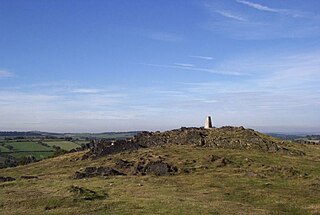
Charnwood Forest is a hilly tract in north-western Leicestershire, England, bounded by Leicester, Loughborough and Coalville. The area is undulating, rocky and picturesque, with barren areas. It also has some extensive tracts of woodland; its elevation is generally 600 feet (180 m) and upwards, the area exceeding this height being about 6,100 acres (25 km2). The highest point, Bardon Hill, is 912 feet (278 m). On its western flank lies an abandoned coalfield, with Coalville and other former mining villages, now being regenerated and replanted as part of the National Forest. The M1 motorway, between junctions 22 and 23, cuts through Charnwood Forest.

The National Museum of Natural History is a natural history museum administered by the Smithsonian Institution, located on the National Mall in Washington, D.C., United States. It has free admission and is open 364 days a year. In 2022, with 3.9 million visitors, it was the most-visited museum in the United States.

The Carnegie Museum of Natural History is a natural history museum in the Oakland neighborhood of Pittsburgh, Pennsylvania. It was founded by Pittsburgh-based industrialist Andrew Carnegie in 1896. Housing some 22 million specimens, the museum features one of the finest paleontological collections in the world.
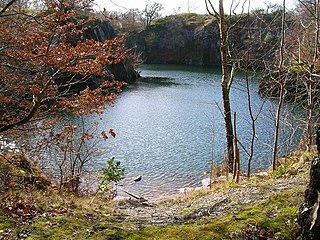
Swithland Wood and The Brand is a 87.9 hectares biological Site of Special Scientific Interest south of Woodhouse Eaves in Leicestershire. Swithland Wood is a Nature Conservation Review site, Grade II. The Brand is designated a Precambrian site in the Geological Conservation Review, but the dating has been changed due to the discovery of trace fossils from the succeeding Cambrian period.
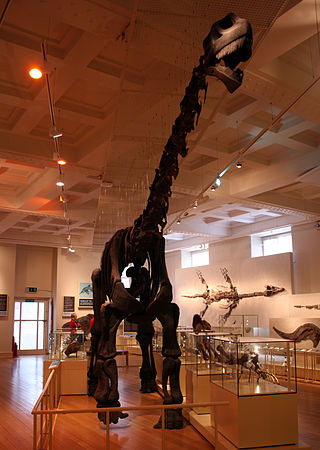
Cetiosaurus meaning 'whale lizard', from the Greek keteios/κήτειος meaning 'sea monster' and sauros/σαυρος meaning 'lizard', is a genus of herbivorous sauropod dinosaur from the Middle Jurassic Period, living about 168 million years ago in what is now Britain.

Cetiosauriscus is a genus of sauropod dinosaur that lived between 166 and 164 million years ago during the Callovian in what is now England. A herbivore, Cetiosauriscus had — by sauropod standards — a moderately long tail, and longer forelimbs, making them as long as its hindlimbs. It has been estimated as about 15 m (49 ft) long and between 4 and 10 t in weight.

The Rocky Mountain Dinosaur Resource Center is a fossil museum primarily exhibiting fossil organisms of North America's Late Cretaceous including dinosaurs, pterosaurs, marine reptiles, and fish. The museum includes a fossil preparation lab and a large gift shop. Live tours are delivered by visitor experience guides highlighting the history of the individual specimens as well as the paleontology of the fossil species they represent. The RMDRC is headquarters to its parent company, Triebold Paleontology Incorporated.
Roger Mason is an English geologist. He is known as the discoverer of the original type fossil for species Charnia masoni of the genus Charnia. He is now a professor at the China University of Geosciences in Wuhan, China.
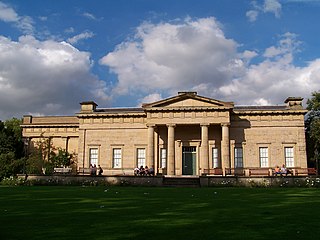
The Yorkshire Museum is a museum in York, England. It was opened in 1830, and has five permanent collections, covering biology, geology, archaeology, numismatics and astronomy.

The Paleozoological Museum of China is a museum in Beijing, China. The same building also houses the Institute of Vertebrate Paleontology and Paleoanthropology of the Chinese Academy of Sciences. The museum contains exhibition halls with specimens aimed at the public, while the rest of the building is used for research purposes.
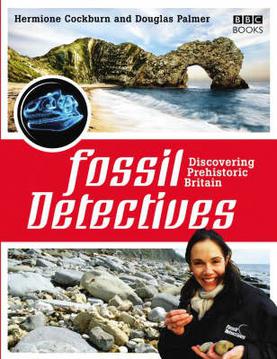
Fossil Detectives is a 2008 BBC Television documentary series in which presenter Hermione Cockburn travels across Great Britain exploring fossil sites and discovering the latest scientific developments in geology and palaeontology. The show is a spin-off of Coast.

Museum of World Treasures is a world history museum in Wichita, Kansas, United States. Among the many items on display are Tyrannosaurus, Daspletosaurus, and Tylosaurus specimens, Egyptian mummies, signatures of all the American presidents, a section of the Berlin Wall, and a genuine shrunken head. The Museum of World Treasures is not limited to a particular era of history, but has opted to display a diverse collection representing many different fields of interest and a wide range of subjects. This museum is a member of the American Alliance of Museums, but is not accredited by the organization.

The Jurassic Museum of Asturias is located in the area of Rasa de San Telmo near the parish of Llastres in the municipality of Colunga, Asturias, Spain. Though the municipality of Ribadesella was initially proposed, Colunga was chosen for the building site in the late 1990s. Several landmarks are visible from the museum including the Bay of Biscay, the Sierra del Sueve, and the Picos de Europa. Strategically located over a mount on the Rasa de San Temo, the museum is in the midst the Jurassic Asturias.
The Sintra Natural History Museum is a museum of natural history located in the historic center of the village of Sintra. The museum has both at national and international level due to the quality and rarity of many of its exhibits.

Ancient Echoes Interpretive Centre is a community-based museum and interpretive centre, founded in 1994, that educates, conserves, protects, and promotes the history, the peoples and the assets of the land forming the Eagle Creek Valley and Coal Mine Ravine located in Herschel, Saskatchewan, Canada.
Hadrynichorde is a frondose organism from the Ediacaran period discovered in Newfoundland, Canada. It is a sessile, benthic marine organism. resembling modern sea whips.


















